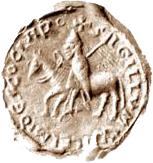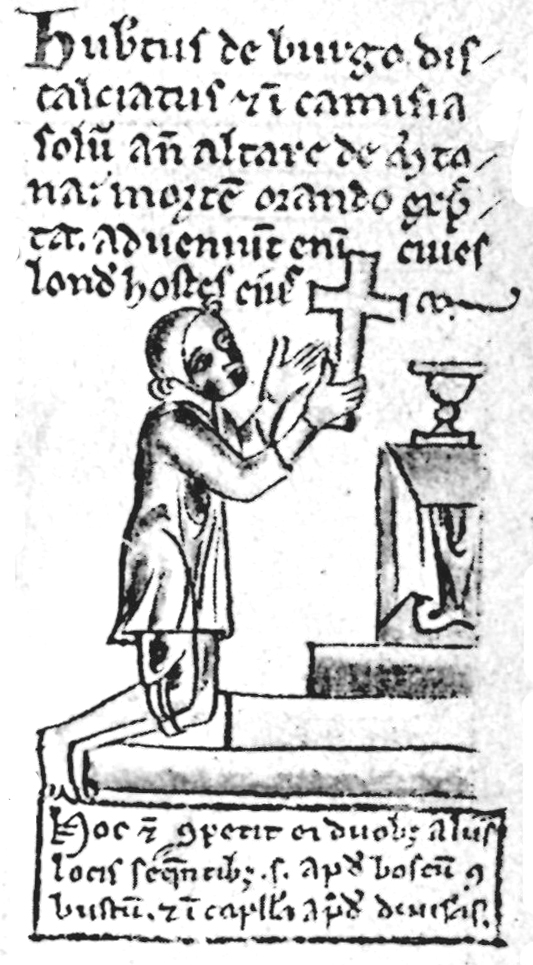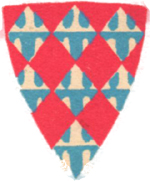The Burgh family
John de Burgh was the son of Hubert de Burgh, Justiciar of England and the Earl of Kent. Hubert was not born into a powerful baronial family, but his gift was to be an able administrator at a particularly chaotic time. He suffered personally from the many petty actions of king Henry III, as well as assembling a vast but disparate estate of lands.
Hubert was one of six children of Walter de Burgh of Burgh-next-Aylsham, Norfolk, and Alice his wife. His brother William was to become Lord of Connaught in Ireland. About 1198, Hubert was appointed chamberlain to John, brother of king Richard I. In 1209 he married a widow, Beatrice de Warenne, by whom he had his only son, John de Burgh (born between 1209 and the death of his mother in 1214). Hubert was holding 15 knights’ fees in Dorset and Somerset in 1210.
In 1215, when the Magna Carta was signed, Hubert supported king John. Opposing the king were many of the country’s barons, of whom 25 were elected as sureties or guarantors that king John would abide by the terms of the charter. One of these barons was William (III) de Lanvalei. In 1215, William was able to retain control of Colchester castle, the only royal castle held by the barons. By November 1216, the king had managed to take back control of the castle and proclaimed William a rebel. Within a year, William had died.
Hawise, the daughter of William (III) de Lanvalei and Matilda Pecche, was a minor when her father died about 1217. Hubert de Burgh obtained her wardship from king John, an astute step given that he and William were on opposing sides. By 1227, the king had given permission for Hubert’s son John to marry Hawise, bringing with her the lands accumulated by the St. Clairs and Lanvaleis, which presumably had also been confiscated by king John.
Hubert became the most powerful official in England during king Henry III’s minority, and was created earl of Kent immediately after Henry succeeded to the throne in 1227. On Hubert’s death in 1243, John succeeded to his hereditary estates, but he could not become the earl of Kent under the terms of its creation. Only the issue of Hubert’s third marriage to Margaret of Scotland would be entitled, and their daughter Margaret had already died in 1237. John held lands in many counties, and when Margaret of Scotland died in 1259, the lands she held, too, reverted to him. A charter granted him, and his heirs, in 1260,
free warren of all demesne lands of Estwode, Reylegh, Wateley, Hatfield-Peverel and Horksleigh in Essex’ and in sundry parts of the counties of Cambridge, Kent, Surrey, Suffolk, Sussex, Bedford, Somerset, Dorset, Gloucester and Nottingham.
John was knighted in 1229, and gained the manors of Dartford, Essendon and Bayford and Hertford castle on the death of his cousin Reymund de Burgh in 1230. Reymund was probably the son of Hubert’s brother, Thomas de Burgh, who was captured by the French at Norwich in 1216 and tried to persuade Hubert to surrender to king Louis at Dover. In 1230, John was also granted custody of Colchester castle, which had previously been held by William (III) de Lanvalei.
When Hubert fell from royal favour in 1232, John also suffered. Still, he held on to some of his lands in Essex and Hertfordshire because they were returned to him after being seized for participating in a tournament at Cambridge without royal licence. John distinguished himself in the English retreat from Saintes on 20 July 1242 and he was with the English armies in Gascony in 1253. In October 1254, the king granted John and son
licence for life to hunt with their own dogs the hare, fox, badger and cat through all forests in the counties of Buckingham, Essex, Nottingham, Huntingdon, Stafford, Northampton and Lancaster.
But in 1261, John joined the barons in the civil war and fought for Simon de Montfort against Henry at Lewes and Evesham, his lands being confiscated in consequence. Unlike the punishment meted out to most of ‘the disinherited’, the king allowed John to enjoy the great patrimony he had received from Hubert for the rest of his life. Not only that, he received the constableships of the Tower of London and Colchester castle, as well as a substantial sum from the moneys accruing to the crown from the city of London. By 1278, John had died.
John and Hawise’s only child was another John. It is not known when he was born, but it would have been between c.1227 when his parents married and 1234, since he accompanied his father to Gascony in 1253. John married Cecilia Balliol and had three daughters who survived him and shared his lands: Hawise, who married Robert de Greilly; Devorguilla (1255-1284), who married Robert FitzWalter of Woodham Walter, Essex; and Margaret, who became a nun at Chicksands Priory in Bedfordshire.
| 1 | 2 | 3 | 4 | 5 | generations | ||||||||
| Walter de Burgh of Burgh-next-Aylsham, Norfolk m. Alice | |||||||||||||
| William de Burgh (-1205/6). Lord of Connaught m. —— | |||||||||||||
| Thomas de Burgh (-after 1216) m. —— | |||||||||||||
| Thomas de Burgh (-after 1210) m. —— | |||||||||||||
| Raymond de Burgh of Dartford, Kent (-1230) | |||||||||||||
| m. Christine (-before 17 Jun 1232), widow of William de Mandeville, Earl of Essex, dau. of Robert FitzWalter | |||||||||||||
| of Woodham Walter, Essex, and Gunnor de Valoignes | |||||||||||||
| Geoffrey de Burgh (-1228), Bishop of Ely. | |||||||||||||
| Unknown daughter m. —— | |||||||||||||
| Thomas de Blunville, Bishop of Norwich | |||||||||||||
| Hubert de Burgh (-12 May 1243). Earl of Kent (1227) and Justiciar of England, | |||||||||||||
| betrothed 28 Apr 1200 to Joan de Vernon (-after 1233), dau. of William de Vernon (Reviers), Earl of Devon, and Mabile de Meulan | |||||||||||||
| m. (2) Sep 1217, Isabel (Avise) (before 1176-14 Oct/18 Nov 1217), Countess of Gloucester, divorced wife (firstly) of John, King of | |||||||||||||
| England, and widow (secondly) of Geoffrey de Mandeville, Earl of Essex, dau. of William FitzRobert, 2nd Earl of Gloucester, and
Avise de Beaumont |
|||||||||||||
| m. (3) Jun/1 Aug 1221, div. 1232, Margaret of Scotland (1193-1259), dau. of William “the Lion” King of Scotland and Ermengarde de Beaumont | |||||||||||||
| Margaret de Burgh (1223-Nov 1237) m. 1237, div. 1237, Richard de Clare (4 Aug 1222-15 Jul 1262), Earl of Gloucester and | |||||||||||||
| Hereford, son of Gilbert de Clare, 4th Earl of Hertford, Earl of Gloucester, and Isabel Marshal of Pembroke | |||||||||||||
| m. (1) 1209, Beatrice de Warenne (-before 12 Dec 1214), dau. of William de Warrene of Wormegay, Norfolk, and Beatrix de Pierrepont | |||||||||||||
| Sir John de Burgh of Henherst, Kent (-1271) m. before 1227, Hawise de Lanvalei, dau. of William (III) de Lanvalei | |||||||||||||
| and Hawise de Pecche | |||||||||||||
| John de Burgh of Wakerley, Northants (before 1234-before 3 Mar 1279) | |||||||||||||
| m. Cecilia Balliol (-before 10 Apr 1273), dau. of John de Balliol of Barnard Castle and Devorguilla of Galloway | |||||||||||||
| Hawise de Burgh m. Robert de Greilly of Manchester, son of Robert de Greilly | |||||||||||||
| Sir Thomas de Greilly of Manchester (8 Aug 1279-before 11 Oct 1311), Baron Greilly 1308, | |||||||||||||
| m. before 2 Nov 1399, dau. ——- Wake | |||||||||||||
| Joan de Greilly (-20/21 Mar 1353) | |||||||||||||
| m. after 19 Nov 1294, John, Lord La Warre (1276-9 May 1347), son of Sir Roger La Warre of Wickwar, | |||||||||||||
| Gloucestershire, and Clarice Tregoz | |||||||||||||
| Isabel de Greilly (-before 8 Jul 1322) m. John de Gyse. No issue | |||||||||||||
| Devorguilla de Burgh (1255-1284) m. Robert FitzWalter of Woodham Walter, Essex (1247-18 Jan 1326), Baron | |||||||||||||
| Fitzwalter 1295, son of Walter FitzRobert and Ida Longespee | |||||||||||||
| Marjory de Burgh, became a nun at Chicksands Priory, Bedfordshire | |||||||||||||


